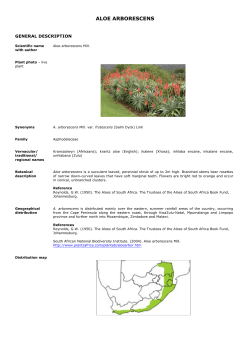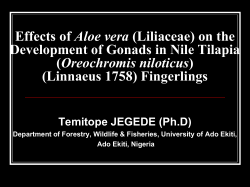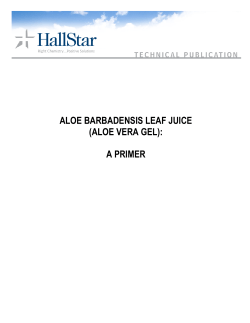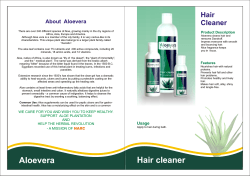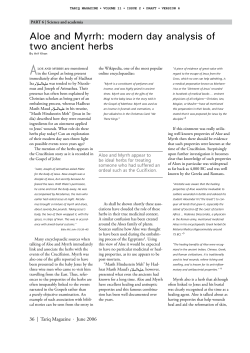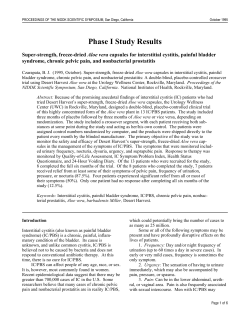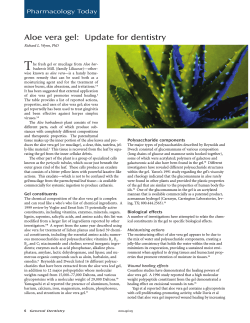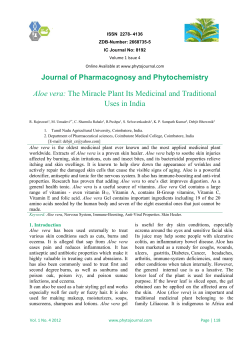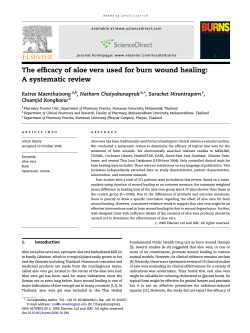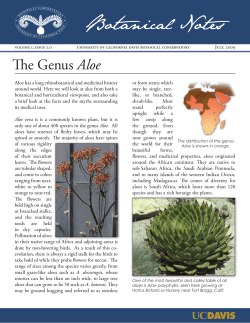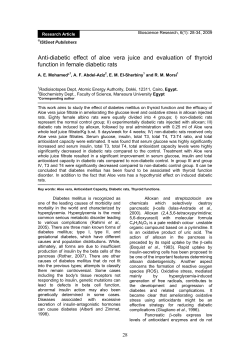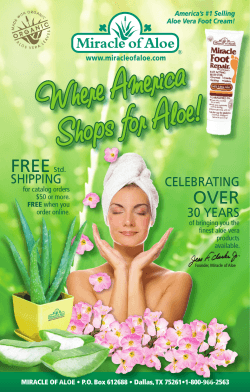
Document 116319
Phytomedicine Vol. 3 (3), pp. 241-243, 1996 © 1996 by Gustav Fischer Verlag, Stuttgart· Jena . New York Antidiabetic activity of Aloe vera L. juice. I. Clinical trial in new cases of diabetes mellitus S. YONGCHAIYUDHA 1, V. RUNGPITARANGSI1, N. BUNYAPRAPHATSARA2 and O. CHOKECHAIJAROENPORN2 I 2 Department of Preventive and Social Medicine, Faculty of Medicine Siriraj Hospital, Mahidol University. Medicinal Plant Information Center, Faculty of Pharmacy, Mahidol University. Summary Aloe vera gel has been claimed to have antidiabetic activity but not all published results are consistent. We investigated the effect of oral administration of one tablespoonful of Aloe vera juice, twice a day for at least 2 weeks in patients with diabetes. Blood sugar and triglyceride levels in the treated group fell; cholesterol levels were not affected. The results suggest the potential of aloe vera juice for use as an antidiabetic agent. Keywords: Aloe vera gel, anti hyperglycemic, antihypertriglyceridemic. Introduction Diabetes mellitus is one of the leading diseases found among the Thai population. Most diabetic patients rely on expensive imported drugs; to lower the expense, substitutes from local resources are needed. Several medicinal plants exhibit antidiabetic activity, among these are a few species of Aloe. Previous reports showed antidiabetic activity of aloe extract (Kuraev et al., 1958; Beppu et al., 1993), latex and anthraquinones (Ghannam et aI., 1986; Ajabnoor, 1990) and gel (Hikino, 1986 a, b; Agarwal 1985; Beppu et al., 1993). However, some negative results have also been reported (Mossa, 1985; Roman-Ramos, 1991; Koo, 1994). The inconsistent results may be due to the instability of gel components. Aloe extract is more stable, but it contains anthraquinones, which cause purgation and weight reduction during chronic treatment (Ajabnoor, 1990). Therefore, we confirmed the efficacy of aloe gel in streptozotocin-induced diabetic rats: both fresh and preserved aloe gel produced antihyperglycemic activity when the rats were given one tablespoonful, twice a day for at least one week (Bunyapraphatsara et al., 1995). Acute and subchronic toxicity studies of aloe gel showed no toxic effect when lyophilized aloe gel was orally administered to albino rats at doses of 1, 4, 16 or 64 mglkg body weight twice daily. No changes in levels of serum glutamic oxaloacetic transaminase (SGOT), serum glutamic pyruvic transaminase (SGPT), blood urea nitrogen (BUN) and creatinine were observed (Wattanasrisin, 1988). Another study showed the same result with fresh and preserved aloe gel: no toxic effect was observed when various doses up to 20 glkg were administered orally or intraperitoneally to mice and rats. Oral administration of fresh and preserved aloe gel at the dose of 5 glkg for 45 days also showed no toxic effect (Jirakulchaiwong et al., 1991). All these findings led us to conduct clinical studies at Siriraj Hospital to investigate the efficacy of preserved aloe gel in the treatment of diabetes mellitus. Materials and Methods Subjects 50 and 22 women were enrolled in the study and divided into equal for treatment and control groups by matching sexes, ages and weights. Each participant was paired with someone of the same sex, with a 5 kg difference in body weights and a 5-year difference in age. The participants were selected from the patients who are the workers at the Soft Drink Center Infirmary under our clinicians a care. They were selected for the study using the following criteria: • Inclusion criteria 1. Aged 35-60 years and never treated with hypoglycemic drugs. 242 S. Yongchaiyudha et al. Table 1 Blood sugar, cholesterol and triglyceride levels of patients treated with aloe gel. Variable mg% (Mean ± SEM) Treated Group 2-tail Prob. results" 48.25±O.76 11:25 47.86±0.69 0.707 NS 251.06±8.02 244.81±7.87 246.67±7.12 254.58±7.52 257.36±7.82 254.50±7.23 257.14±7.78 250.36±7.65 233.83±7.84 209.64±7.52 186.42±6.13 166.03±5.96 151.17±5.42 141.92±4.12 0.950 0.327 0.001 0.000 0.000 0.000 0.000 NS NS S S S S S 228.42±7.42 230.86±6.27 232.81±6.02 241.83±5.73 234.28±6.93 233.17±6.06 231.81±6.11 234.97±5.88 0.566 0.792 0.908 0.406 NS NS NS NS 214.31±10.77 220.47±10.55 217.19±9.66 232.44±9.59 220.31±11.40 189.94±10.77 155.36±7.65 122.72±5.46 0.703 0.047 0.000 0.000 NS NS S S Control Group Sexf:m Age (years) Blood Sugar day 1 day 7 day 14 day 21 day 28 day 35 day 42 Blood Cholesterol day 1 day 14 day 28 day 42 Blood Triglyceride Levels day 1 day 14 day 28 day 42 11:25 Statistical " Significantly differentfrom control at P = 0.01. 2. High fasting blood sugar and typical diabetic curve of glucose tolerance analysis. 3. Freely consented to participate in the study. • Exclusion criteria 1. Liver disease as defined by abnormal levels of SGOT and alkaline phosphatase. 2. Kidney disease as defined by abnormal levels of blood urea nitrogen (BUN) creatinine and urine examination (specific gravity and albumin content). • Study design The study was a placebo-controlled and single-blind trial. Sample Aloe vera juice (80%) with suitable preservatives was prepared from aloe gel at the faculty of Pharmacy, Mahidol University. Aloe juice was squeezed from aloe gel, then flavors and preservatives were added to the juice. Sorbitol was used as sweetening agent. The control group received a carminative mixture. Procedure 1. The control group received the placebo and the treatment group received one tablespoonful of aloe juice twice a day, in the morning and before bed time, for 42 days. 2. Blood samples were taken weekly for measurement of fasting blood glucose (FBS) levels and every two weeks for triglyceride and cholesterol analyses. The blood chemistry was done at Siriraj hospital. Data analysis Student's t-test and paired student t-test were used to compare the values between and within the groups. The 99% confidence limit (P = 0.01) was chosen for statistical significance. Termination of the study This occurred when 1. Subjects experienced serious adverse effects as determined by physicians. 2. Subjects developed symptoms and signs of acute diabetic complications. 3. Subjects developed an acute illnesses that affected the trial. 4. Subjects elected to terminate their participation in the study. Results Before treatment, the patients in the control and treated groups showed no statistically significant differences in blood sugar, cholesterol or triglyceride levels. The blood sugar levels of patients who received aloe juice were significantly reduced after one week and continued to fall steadily throughout the treatment period; those of the control group did not change (Table 1). The triglyceride levels of the treated group were significantly reduced after 2 weeks of treatment and fell further by the end of the study (Table 1). Cholesterol levels were not affected by administration of aloe juice (Table 1). Antidiabetic activity of Aloe vera L. 1. Discussion Our study showed Aloe vera gel possesses antidiabetic activity. This confirmed a previous report by Agarwal (1985) who conducted a clinical trial on 5,000 patients with angina pectoris over five years. After adding aloe gel to the diet he found a marked reduction in total cholesterol, triglycerides, fasting and post-prandial blood sugar levels in diabetic patients, decrease in total lipid and increase in HDL. We observed a significant decrease in fasting blood sugar and triglyceride levels, but cholesterol levels were not statistically different from the control and pretreatment values. The active components of aloe gel are polysaccharides (Hikino et al. 1986, a, b) and glycoprotein (Beppu, 1993). In this study, the active constituents were not isolated; however, gel electrophoresis analysis showed the presence of glycoproteins (data not shown). The results suggest aloe gel has potential in treating diabetes because it can lower not only sugar but also triglyceride levels which are often high in diabetic patients. Further studies on the active constituents of preserved aloe and more clinical data are needed before promoting aloe gel as an antidiabetic drug in Thailand to substitute for expensive drugs. Only one out of 40 patients dropped out of the study because of diabetic complications (ketosis). The other patient with whom this individual was paired was then also dropped out from the study. The low drop - out rate was due to the good follow up by clinicians who visit the Soft Drink Center Infirmary every week. It should be noted that physical check ups before and after treatment found no difference in weight and appetite. References Agarwal, O. P.: Prevention of atheromatous heart disease. Angiology, 36 (8): 485-92, 195. Ajabnoor, M. A.: Effect of aloes on blood glucose levels in normal and alloxan diabetic mice. J. Ethnopharmacol, 28: 215-20, 1990. Beppu, H., Nagamura, Y., Fujita, K.: Hypoglycemic and antidia- 243 betic effects in mice of Aloe arborescens Miller var. natalensis Berger. Phytotherapy Res, 7: 537-542, 1993. Bunyapraphatsara, N., Chansrakaew, W., Pornchirasilp, 5., Peungvicha, P., Chokechaijaroenporn, 0.: Antidiabetic effect of fresh and preserved aloe gel. Thai]. Phytopharmacy, 2 (2): 1-7, 1995. Ghannam, N., Kingston, M., Al-Meshall, I. A., Tariq, M.: The antidiabetic activity of aloes: preliminary clinical and experimental observations. Hormone Res, 24: 288-94, 1986. Hikino, Y, Takashi, M., Murakami, M., Konno, C, Mirin, Y., Karikura, M., Hayashi, T.: Isolation and hypoglycemic activity of arboran A and B, glycans of Aloe arborescens var. natalensis leaves. Int] Crude Drug Res, 24 (4): 183-6, 1986a. Hikino, H., Teruaki, 5., Kawanishi, H.: Method of treating hypoglycemia using aloe polysaccharides. U.S. Patent 4, 598, 069, 1986 b. jirakulchaiwong, 5., Wongkrajang, Y., Bunyapraphatsara, N., Atisuk, K.: Toxicological evaluation of fresh and preserved aloe gel. In Progress on terrestrial and marine natural products of medicinal and biological interest. Proceedings of a symposium held on the occasion of the 60th birthday of Professor N. R. Farnsworth. Chicago, Illinois at Chicago, Illinois, 91-97, 1991. Koo, M. L. U. L.: Aloe vera: antiulcer and antidiabetic effects. Phytotherapy Res, 8: 461-4,1994. Kuraev, A. L., Aliev, R. K., Guseinov, G. A., Gadashev, A. G.: Effect of certain plants on sugar tolerance. Izuest Akad Nauk Azerbatsdhan. S.S.R., Ser Bioi I Sel'skokhoz. Nauk, 3: 81-02, 1958. Through Chern Abstr 52: 20682 f., 1958. Mossa, J. 5.: A study on the crude antidiabetic drugs used in Arabian folk medicine. Int Crude Drug Res, 23 (3): 137-45, 1985. Roman-Ramos, R., Flores-Saenz,]. L., Partida-Harnandez, G., Lara-lemus, A., Alarcon Aguilar, E: Experimental study of the hypoglycemic effect of some antidiabetic plants. Archivos de Investigcion Medica, 22 (1): 87-93, 1991. Watanasrisin, J.: Effect of Aloe vera gel on serum transaminase, BUN, and creatinine levels in weanling rats, MS Thesis, Faculty of Science, Mahidol University, Thailand, 1988. Address Nuntavan Bunyapraphatsara, Medicinal Plant Information Center, Faculty of Pharmacy, Mahidol University, Sri-Ayudhaya Road, Bangkok 10400, Thailand; Tel.: 66-2-2482143; Fax: 66-2-248-21 43.
© Copyright 2025

